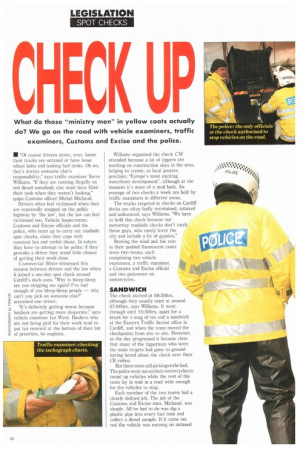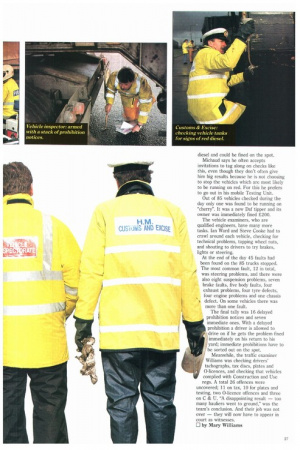C HECK UP
Page 28

Page 29

If you've noticed an error in this article please click here to report it so we can fix it.
• "Of course drivers never, ever, know their trucks are untaxed or have loose wheel bolts and leaking fuel tanks. Oh no, that's always someone else's responsibility," says traffic examiner Steve Williams. "If they are running illegally on red diesel somebody else must have filled their tank when they weren't looking," quips Customs officer Michel Michaud.
Drivers often feel victimised when they are repeatedly stopped on the public highway by 'the law', but the law can feel victimised too. Vehicle Inspectorate, Customs and Excise officials and the police, who team up to carry out roadside spot checks, claim they cope with constant lies and verbal abuse. In return they have to attempt to be polite; if they provoke a driver they stand little chance of getting their work done.
Commercial Motor witnessed this tension between drivers and the law when it joined a one-day spot check around Cardiff's dock area. "Why in bleep-bleep are you stopping me again? I've had enough of you bleep-bleep people — why can't you pick on someone else?" g screamed one driver.
>. "It's definitely getting worse because hauliers are getting more desperate," says vehicle examiner Ian Ward. Hauliers who g are not being paid for their work tend to put tax renewal at the bottom of their list of priorities, he explains.
Williams organised the check CM attended because a lot of tippers are working on construction sites in the area, helping to create, as local posters proclaim: "Europe's most exciting waterfront development", although at the moment it's more of a mud bath. An average of two checks a week are held by traffic examiners in different areas.
The trucks targeted in checks on Cardiff docks are often badly maintained, untaxed and unlicenced, says Williams. "We have to hold this check because our motorway roadside checks don't catch these guys, who rarely leave the city and include a lot of gypsies."
Braving the wind and the rain in their padded fluorescent coats were two teams, each comprising two vehicle examiners, a traffic examiner, a Customs and Excise official and two policemen on motorcycles.
SANDWICH
The check started at 08:30hrs, although they usually start at around 07:00hrs, says Williams. It went through until 15:30hrs, apart for a break for a mug of tea and a sandwich at the Eastern Traffic Sector office in Cardiff, and when the team moved the checkpoints from site to site. However, as the day progressed it became clear that many of the tippermen who were the main targets had gone to ground having heard about the check over their CB radios.
But there were still pickings to be had. The police went out on their motorcycles to round up vehicles while the rest of the team lay in wait in a road wide enough for the vehicles to stop.
Each member of the two teams had a clearly defined job. The job of the Customs and Excise man, Michaud, was simple. All he had to do was dip a plastic pipe into every fuel tank and collect a diesel sample. If it came out red the vehicle was running on untaxed diesel and could be fined on the spot.
Michaud says he often accepts invitations to tag along on checks like this, even though they don't often give him big results because he is not choosing to stop the vehicles which are most likely to be running on red. For this he prefers to go out in his mobile Testing Unit.
Out of 85 vehicles checked during the day only one was found to be running on "cherry". It was a new Daf tipper and its owner was immediately fined £200.
The vehicle examiners, who are qualified engineers, have many more tasks. Ian Ward and Steve Cooke had to crawl around each vehicle, checking for technical problems, tapping wheel nuts, and shouting to drivers to try brakes, lights or steering.
At the end of the day 45 faults had been found on the 85 trucks stopped.
, The most common fault, 12 in total,
r was steering problems, and there were also eight suspension problems, seven brake faults, five body faults, four exhaust problems, four tyre defects, four engine problems and one chassis
■ defect. On some vehicles there was more than one fault.
The final tally was 16 delayed . prohibition notices and seven immediate ones. With a delayed prohibition a driver is allowed to :i drive on if he gets the problem fixed i immediately on his return to his ; yard; immediate prohibitions have to ) be sorted out on the spot. fMeanwhile, the traffic examiner Williams was checking drivers' tachographs, tax discs, plates and 0-licences, and checking that vehicles complied with Construction and Use regs. A total 26 offences were uncovered; 11 on tax, 10 for plates and testing, two 0-licence offences and three on C & U. "A disappointing result — too many hauliers went to ground," was the team's conclusion. And their job was not over — they will now have to appear in court as witnesses.
El by Mary Williams




























































































